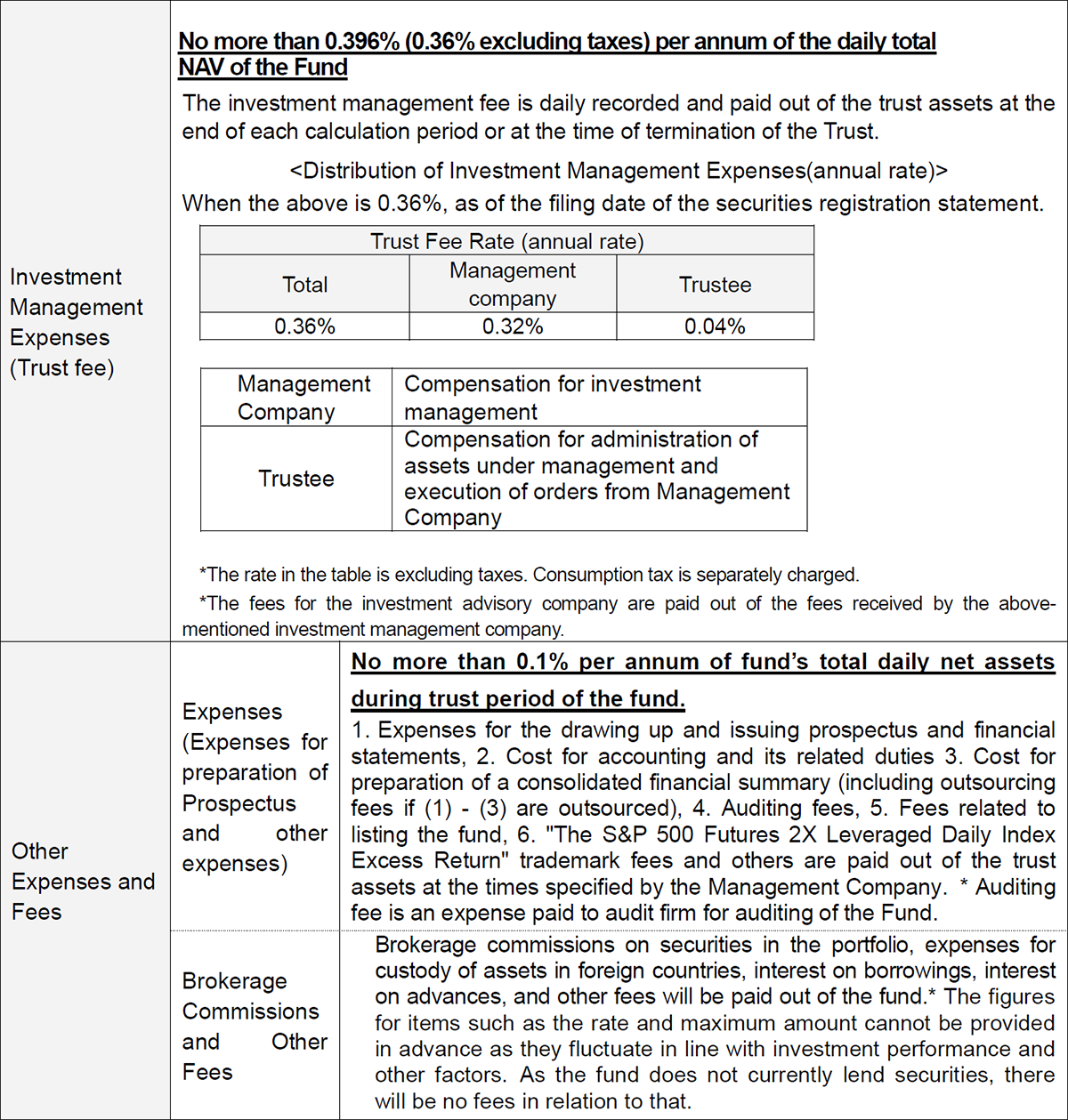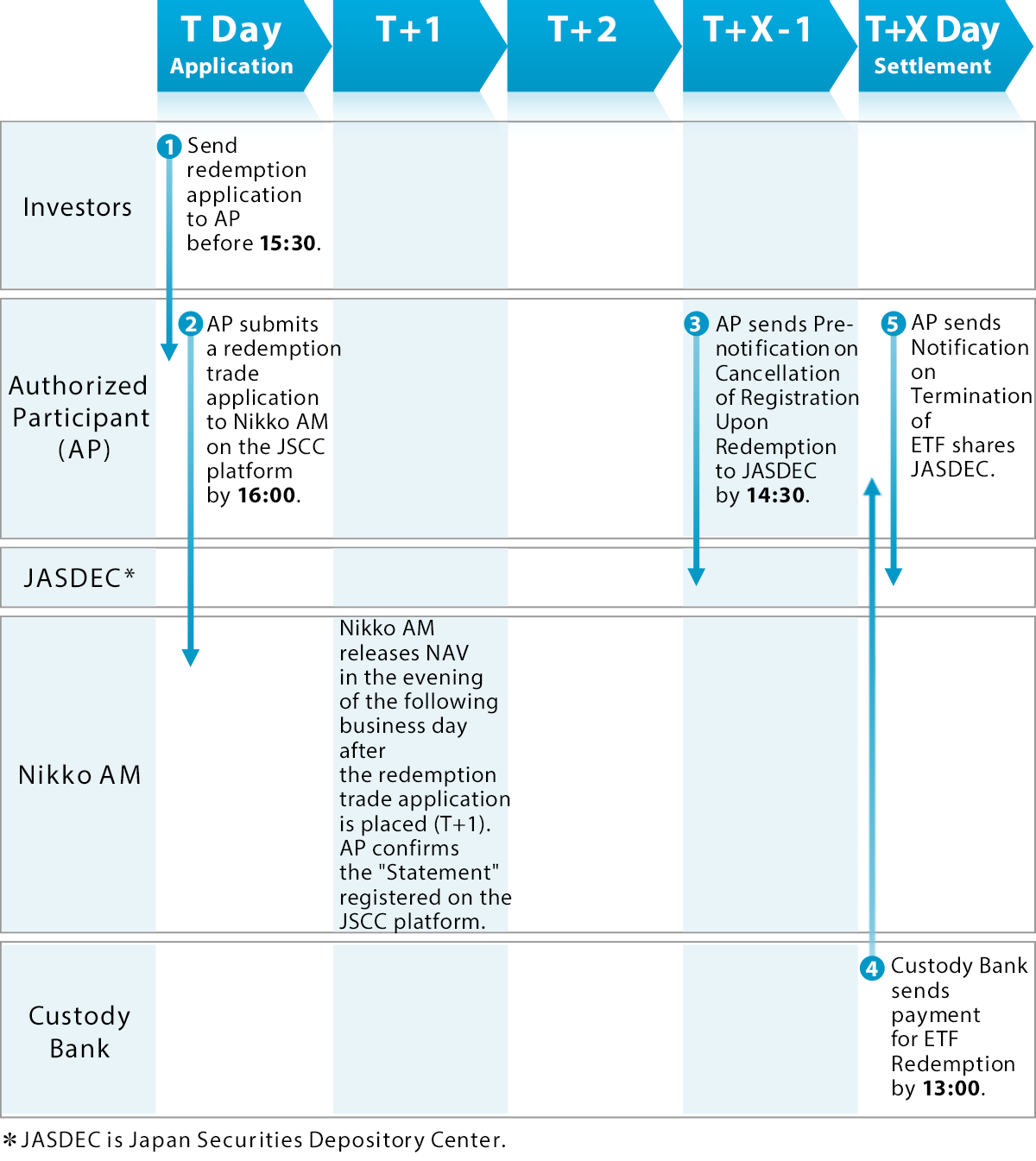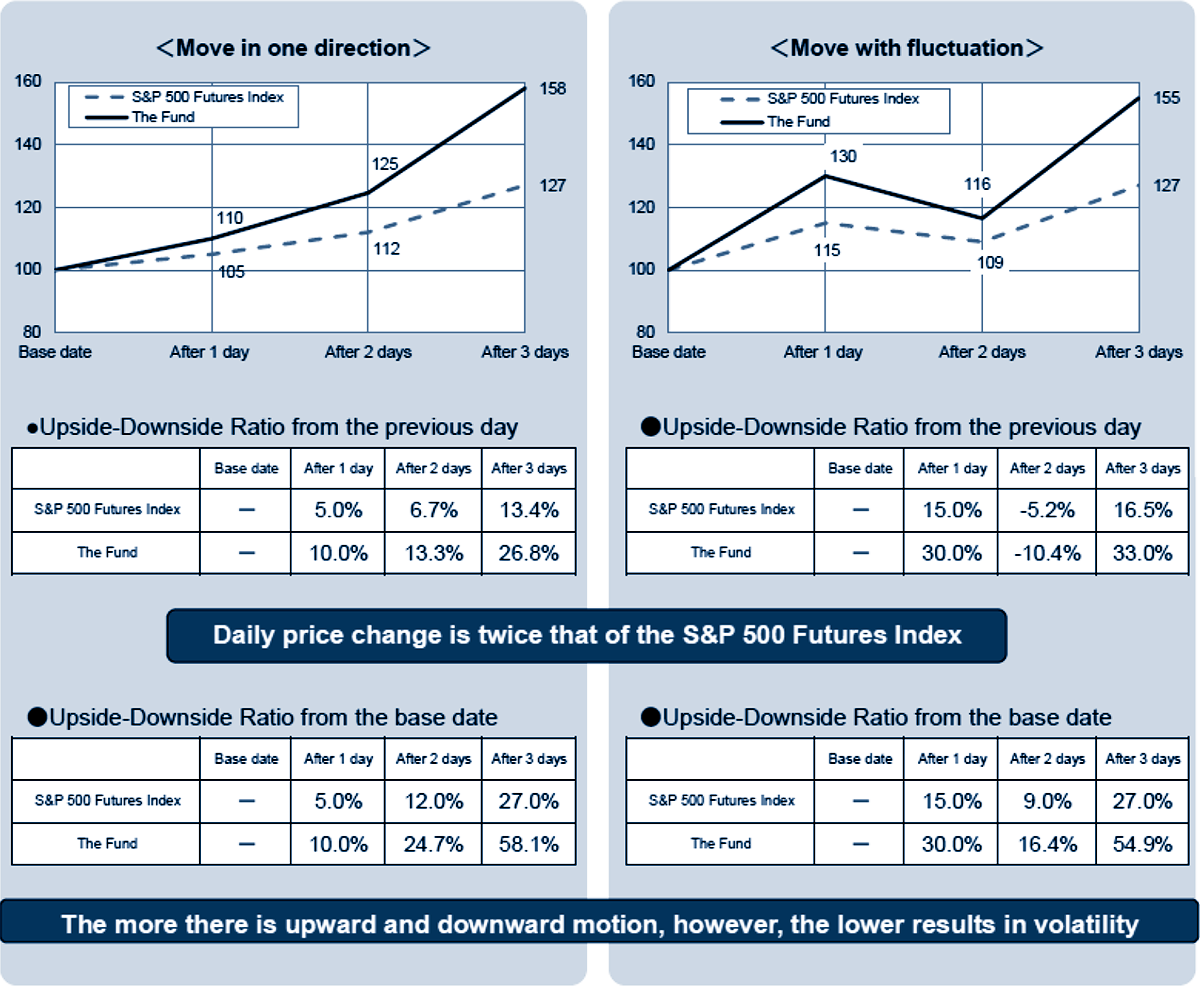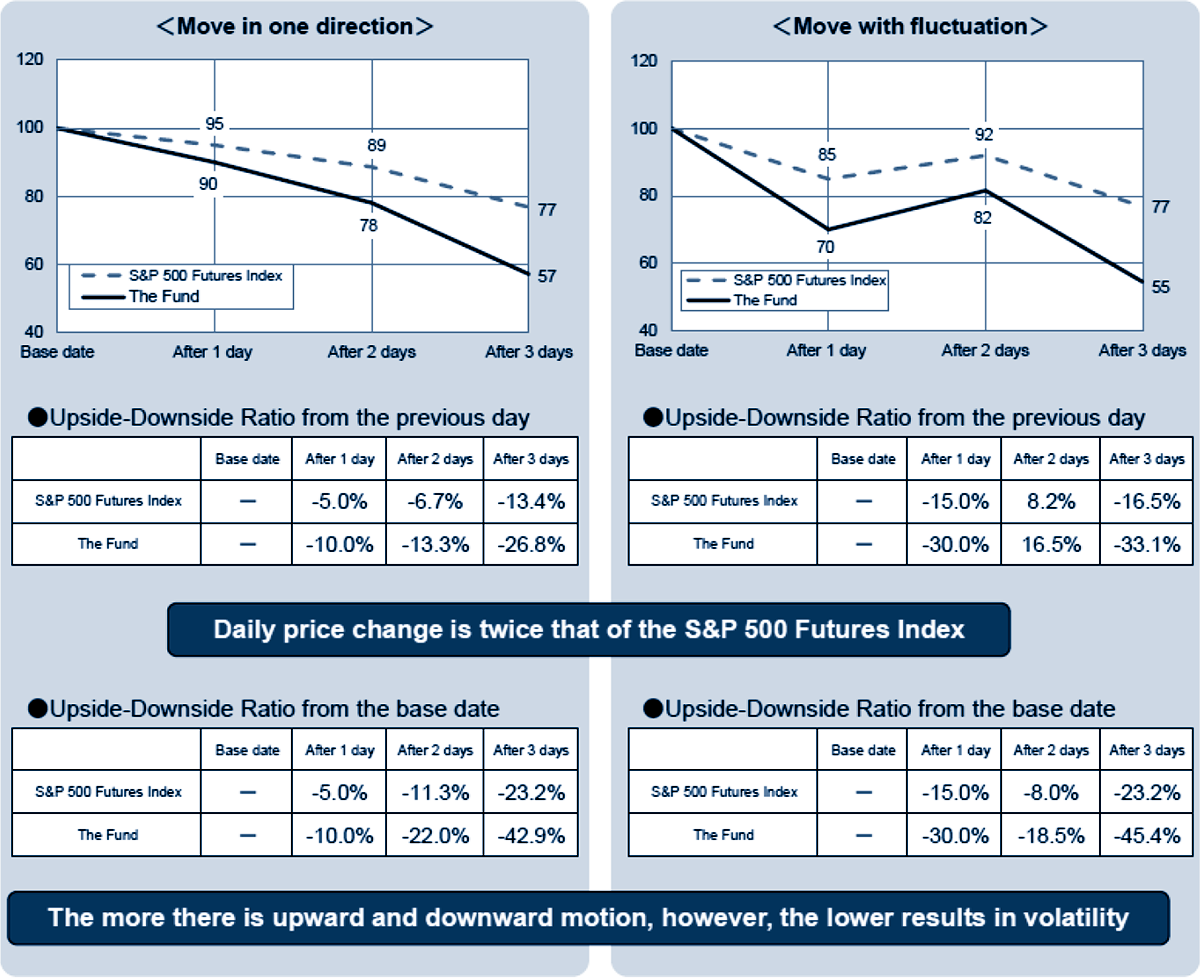On September 1, 2025, Nikko Asset Management Co., Ltd. will change its name to Amova Asset Management Co., Ltd.
This fund restricts US persons (including US residents, legal persons and other entities which are established under US law or which have their principal place of business in the US and pension plans for their officers and employees, and estates and trusts, the income of which is subject to US income tax) from purchasing or holding units of the fund.
The Fund involves a high NAV fluctuation risk, so when applying for the fund, you should be fully aware of and consider the risks of the fund and make a careful investment decision.
The fund seeks investment results that track the movement of the S&P 500 Futures 2X Leveraged Daily Index Excess Return.
Key information
| Name: | Listed Index Fund S&P500 Futures Leveraged Two Times | |
| Code: | 2239 |
Net Asset Value and Performance
| Fund Name | Listed Index Fund S&P500 Futures Leveraged Two Times Open-end/Overseas/Equities/ETF/Index-type |
| Listed Exchange | Tokyo Stock Exchange |
| Issue Code | 2239 |
| Targeted Investments | The fund seeks the net asset value per unit to track the performance of the S&P 500 Futures 2X Leveraged Daily Index Excess Return by making daily adjustments so that the total market value of long U.S. stock index futures position is about twice the net asset value, in addition to investing primarily in domestic and foreign public and corporate bonds. |
| Date Listed | March 17, 2023 (launched on March 14, 2023) |
| Exchange Trading Unit | 1 unit |
| Trust period | Unlimited |
| Computation Period | From 21 January of each year to 20 January of the next year |
| Closing Date | 20 January of each year |
| Dividends | As a general rule, the full amount of dividends and other income arising from the trust assets is distributed after deduction of expenses. *There is no guarantee for the amount and payment of dividends in the future. |
Fund Expenses
■Expenses to be borne directly by investors
| Subscription Fee | Independently set by Distributors *Please contact your Distributor for further information. *Subscription Fee is compensation for explanation and information providing about the Fund or investment environment, and is also including expense of clerical processing of the subscription. |
| Exchange Fee | Independently set by Distributors *Please contact your Distributor for further information. *Exchange Fee is compensation for clerical processing of the exchange. |
| Amount to be Retained in Trust Assets | None. |
■Expenses to be borne indirectly by investors from trust assets
| TER (Total Expense Ratio) |
0.65% (TER includes Trust Fee, management fee and other costs below) Please refer to the prospectus for details. |

The total amount of expenses of the Fund to be borne by investors varies according to holding length and investment status, and thus cannot be shown.
Main Investment Restrictions
|
Trustee Companies
|
*The S&P 500 Futures 2X Leveraged Daily Index Excess Return is an index calculated by doubling the daily return of the S&P 500 Futures Index Excess Return. The base date is September 9, 1997 and the index value on that date is calculated as 100 points.
*Excess returns in futures index does not take interest rates into account.
*The volatility of the S&P 500 Futures 2X Leveraged Daily Index Excess Return is not necessarily twice that of the S&P 500 Futures Index Excess Return when compared with period of more than two days due to compounding effects and other factors.
Further Information
Japan Exchange Group (JPX)
Japan Exchange Group publishes summaries and lists of the ETFs, as well as other valuable information on their website.
S&P Global
- Listed ETF iNav
Please click this link to see the iNAV.
Standard & Poor's
- S&P 500 Futures 2X Leveraged Daily Index Excess Return
Fact Sheet, Methodology (Click on "+ Documents")
*Link to external sites.
Copyrights of the "S&P 500 Futures 2X Leveraged Daily Index Excess Return"
The "S&P 500 Futures 2X Leveraged Daily Index Excess Return" is a product of S&P Dow Jones Indices LLC or its affiliates (“SPDJI”), and has been licensed for use by Nikko Asset Management Co., Ltd.. S&P®, S&P 500®, US 500, The 500, iBoxx®, iTraxx® and CDX® are trademarks of S&P Global, Inc. or its affiliates (“S&P”); Dow Jones® is a registered trademark of Dow Jones Trademark Holdings LLC (“Dow Jones”); These trademarks have been licensed for use by SPDJI and sublicensed for certain purposes by Nikko Asset Management Co., Ltd.. "Listed Index Fund S&P500 Futures Leveraged Two Times" is not sponsored, endorsed, sold or promoted by SPDJI, Dow Jones, S&P, their respective affiliates and none of such parties make any representation regarding the advisability of investing in such product(s) nor do they have any liability for any errors, omissions, or interruptions of the "S&P 500 Futures 2X Leveraged Daily Index Excess Return".
The fund seeks investment results that track the movement of the S&P 500 Futures 2X Leveraged Daily Index Excess Return.
- The fund seeks the net asset value per unit to track the performance of the S&P 500 Futures 2X Leveraged Daily Index Excess Return by making daily adjustments so that the total market value of long U.S. stock index futures position is about twice the net asset value, in addition to investing primarily in domestic and foreign bonds.
*The Fund is substantially managed by Nikko Asset Management Americas, Inc.*.
*Nikko Asset Management Americas, Inc. will change its name to Amova Asset Management Americas, Inc. on September 1, 2025
*The Fund may invest in Money Account Mother Fund that aim to secure stable income by investing in public and corporate bonds.
*The Fund seeks to reduce the currency fluctuations risk through currency hedging, but this does not completely eliminate the currency fluctuations risk. When hedging against foreign exchange fluctuation risk, if the short-term interest rate of JPY is lower than that of the underlying currency, the hedging cost will be incurred.
*The investment management described above may not be carried out due to market and financial conditions.
Units are listed on Tokyo Stock Exchange (scheduled to be listed on March 17, 2023) and can be traded at any time during trading hours.
- Units may be traded in blocks of 10 unit (as of the date when the securities registration statement was filed).
- The brokers determine trading commissions.
- The method of trading is generally the same as that for stocks.
*Please contact your broker for further information.
Units are subscribed for with cash.
- Units are subscribed using the NAV on the following business day when the subscription is accepted.
Units may be redeemed with a request for redemption.
- Units may be redeemed by the NAV on the following business day when redemption is accepted.
Units may not be exchanged for public and corporate bonds.
This Fund can be applied for as a cash creation and a cash redemption at Authorised Participants in addition to the Tokyo Stock Exchange. When applying as a direct addition and exchange, please keep in mind that we cannot accept your application on the following dates:
Authorized Participants
- ABN AMRO Clearing Tokyo Co., Ltd.
- Barclays Securities Japan Limited
- BNP Paribas Securities (Japan) Limited
- Goldman Sachs Japan Co.,Ltd.
- Mitsubishi UFJ Morgan Stanley Securities Co., Ltd.
- Nomura Securities Co.,Ltd.
- SMBC Nikko Securities Inc.
Daily Creation and redemption are based on ETF's NAV calculated in early evening. Confirm non-tradable days by referring to trading calendar on our official homepage. Basket for creation is continually-updated on our official homepage.
Basically sell/buy at last price of T day's market while FX rate is TTM of one business day after the application (10am on T+1)
The flow chart below is showing the creation/redemption process for Nikko AM ETFs. Please note that transactions cannot be processed for days on which applications are not accepted.
Creation Flow for Cash Creation/Redemption Type ETFs

Redemption Flow for cash Creation/Redemption Type ETFs

Invested principal is not guaranteed and may incur losses when the value of your investment principal may fall below the principal amount as the result of a decline in market price or NAV. All gains and losses from the management of the fund belong to the investor (beneficiary). This fund also differs from bank deposits.
As the fund is mainly invested in bonds and rights to stock index futures contracts, it may experience losses from falls in NAV caused by adverse impacts from bond price drops, fluctuations in the price of rights to stock index futures contracts or adverse changes in a bond issuer’s financial situation or results. Losses may also occur from exchange rate fluctuations if assets denominated in foreign currencies are included.
The major risks of the fund are as follows:
Price Fluctuation Risk
- Corporate and government bonds generally have a price fluctuation risk arising from changes in interest rates. Generally, the prices go down when interest rates rise, causing the fund NAV to fall. However, the range of price fluctuation varies by bond depending on duration, issuance conditions such as coupon rate and others.
- The price of rights for stock index futures contracts fluctuates under the influence of the underlying company’s stock price on which the stock index is calculated, and the price movements of the stock market that makes up the stock index. In addition, the price may fluctuate in tandem with the price movements of other stock price indices in Japan and overseas. In the event of unexpected fluctuations in the prices of stocks related to the stock index or the stock markets that make up the stock index, the price of rights to stock index futures contracts may also fluctuate unexpectedly, and there is a risk of significant losses.
Liquidity Risk
- There is a risk that the fund will incur unexpected losses when the market size or trading volumes is small. The purchase and sale prices of securities and stock index futures contract are influenced by the trading volume, resulting in the risks that they cannot be traded at prices expected to be realized in light of the prevailing market trend, cannot be sold at the estimated prices, or that the trading volume is limited regardless of the level of prices.
Credit Risk
- If a default has occurred or is expected to occur, for issues of public and corporate bonds or short-term financial assets, the prices of such public and corporate bonds or short-term financial assets decline (the value could even fall to zero). This results in a decline of the Fund's NAV. Also, if default in fact occurs, there is a high possibility of being unable to collect investment funds.
Currency Fluctuation Risk
- The Fund, in general, seeks to reduce the currency fluctuations risk through currency hedging. But it does not completely eliminate this risk. When hedging against foreign currency fluctuation risk, if JPY interest is lower than that of the underlying currency, the hedging cost equivalent to this difference will be incurred. Depending on foreign exchange and interest rate trends, currency hedging costs may be higher than expected.
Derivatives Risk
- Financial derivatives based finance contracts may be used, therefore the value of derivatives will fluctuate depending on the value of underlying assets. The price of derivatives will fluctuate more than the underlying assets depending of the type of derivative.
Leverage Risk
- The "S&P 500 Futures 2X Leveraged Daily Index Excess Return" that the Fund targets to be linked to is an index whose daily return is calculated to be twice the return of the S&P 500 Futures Index Excess Return and the fund makes daily adjustments so that the total market value of long U.S. stock index futures position is about twice the net asset value. Therefore, the fund will be greatly impacted by the conditions of the stock market. If the S&P 500 Futures Index Excess Return declines, the fund may incurs larger loss than the S&P 500 Futures Index Excess Return.
Risk - Not Able to Invest as Planned
There might be cases when the Fund may not be able to be invested as planned or the target return on investment are not achieved due to the following factors:
- When the S&P 500 index fluctuates immensely and the stock price index futures trading reach the daily trading limit (max or min).
- When all or part of the required trade volume cannot be executed due to a drop in the liquidity of stock price index futures market, etc.
- When significant fluctuation of investment funds occurs due to additional subscription and redemption.
<Discrepancy between the S&P 500 Futures 2X Leveraged Daily Index Excess Return and NAV>
The Fund seeks to match the volatility of the NAV with that of the S&P 500 Futures 2X Leveraged Daily Index Excess Return. However, the Fund cannot guarantee the movement consistent with the index due to the following factors.
- The total market value of long U.S. stock index futures position is not necessarily equal twice the net asset value.
- Differences between the execution price and the valuation(closing price) of stock index futures contracts corresponding to daily additional subscription and redemption
- The delivery month of the futures contract used in the S&P 500 Futures 2X Leveraged Daily Index Excess Return and those held by the fund do not perfectly match due to the timing of the rollover.
- Interest from bonds and cash deposits, and hedging costs from currency hedging.
- The fund must pay trust fees, brokerage commissions, audit fees, and other expenses.
- The impact from the minimum trading unit for stock index futures contract.
Discrepancy between market price on the Tokyo Stock Exchange and NAV
Although the Fund is listed and publicly traded on the Tokyo Stock Exchange, the market price of the Fund depends primarily on the demand for the Fund, the Fund's performance and investors' assessment of the Fund's attractiveness compared with other investments. Therefore, it is not possible to predict whether the market price of the Fund will trade below or above its NAV.
※A note on the properties inherent in the S&P 500 Futures 2X Leveraged Daily Index Excess Return
- The S&P 500 Futures 2X Leveraged Daily Index Excess Return is calculated so that the rate of return for the business day in comparison to the previous business day is twice that of the S&P 500 Futures Index Excess Return for the same period. However, the rate of return of the S&P 500 Futures 2X Leveraged Daily Index Excess Return for periods more than two business days apart will generally not be twice the rate of the S&P 500 Futures Index Excess Return due to compounding effects and other factors, and there will be a difference in calculation.
- The difference between the rate of return of the S&P 500 Futures 2X Leveraged Daily Index Excess Return and twice that of the S&P 500 Futures Index Excess Return over a period of two or more business days apart will vary depending on the movement of the S&P 500 Futures Index Excess Return during the period and can be in either a positive or negative direction. However, in general, if the movement of the S&P 500 Futures Index Excess Return repeatedly rises and falls within a certain range, the difference will likely be in a negative direction and the index value of the S&P 500 Futures 2X Leveraged Daily Index Excess Return will likely be diminishing gradually. In general, the longer the time period, the greater the difference will tend to be.
※Factors that may cause fluctuations in NAV are not limited to those listed above.
Additional Considerations
- This document is meant as promotional material whose purpose is for Nikko Asset Management to provide information about its "Listed Index Fund S&P500 Futures Leveraged Two Times" and for investors to gain further understanding about the fund.
- The provisions stipulated in Article 37-6 of the Financial Instruments and Exchange Act (the “cooling-off period”) are not applicable to Fund transactions.
- This Fund differs from deposits or insurance policies in that it is not protected by the Deposit Insurance Corporation of Japan or the Policyholders Protection Corporation of Japan. Nor are investment trusts protected by investor protection funds when purchased at banks or other registered financial institutions.
- When the Fund faces big redemption causing short term cash requirement or sudden change in the main trading market condition, there can be temporal decline in the liquidity of holding assets, resulting in the risks that Fund unable to trade securities at the expected market prices or appraised prices, or encounters limitation in trading volume. This may result in the negative influence on NAV, suspension of redemption applications, or delay in making payment of redemption.
- The rate of increase or decrease in the Fund's NAV for a period of two or more business days is usually not two times of the S&P 500 Futures Index Excess Return for the same period. Therefore, there is a risk that expected investment results may not be achieved if held for a long term. For the above reasons, the Fund is a financial instrument that is generally not suitable for long term investment, but rather for capturing market conditions over a relatively short term.
- When applying to invest in the Fund, please make the decision to invest carefully after taking the time to read the delivered pre-agreement document and other relevant materials in detail.
Q&A: About the Fluctuation of the NAV
Q. If the daily movement of NAV is twice that of the S&P 500 Futures Index Excess Return (hereinafter, the "S&P 500 Futures Index"), is the investment result also doubled during the holding period?
A. Even if the daily movement of the NAV is twice that of the S&P 500 Futures Index, it does not mean that each investor will receive twice investment results if the holding period is more than two days.
Charts Demonstrating the NAV Price Changes (when the S&P 500 Futures Index is on the rise)

*Calculation of the above upside-downside ratio is rounded to one decimal place.
*Graphs and data are only examples of calculations and highlight the relation between the price change of the overall stock market and NAV. They do not indicate the actual price movement.
Charts Demonstrating the NAV Price Changes (when the S&P500 Futures Index is on the decline)

*Calculation of the above upside-downside ratio is rounded to one decimal place.
*Graphs and data are only examples of calculations and highlight the relation between the price change of the overall stock market and NAV. They do not indicate the actual price movement.


